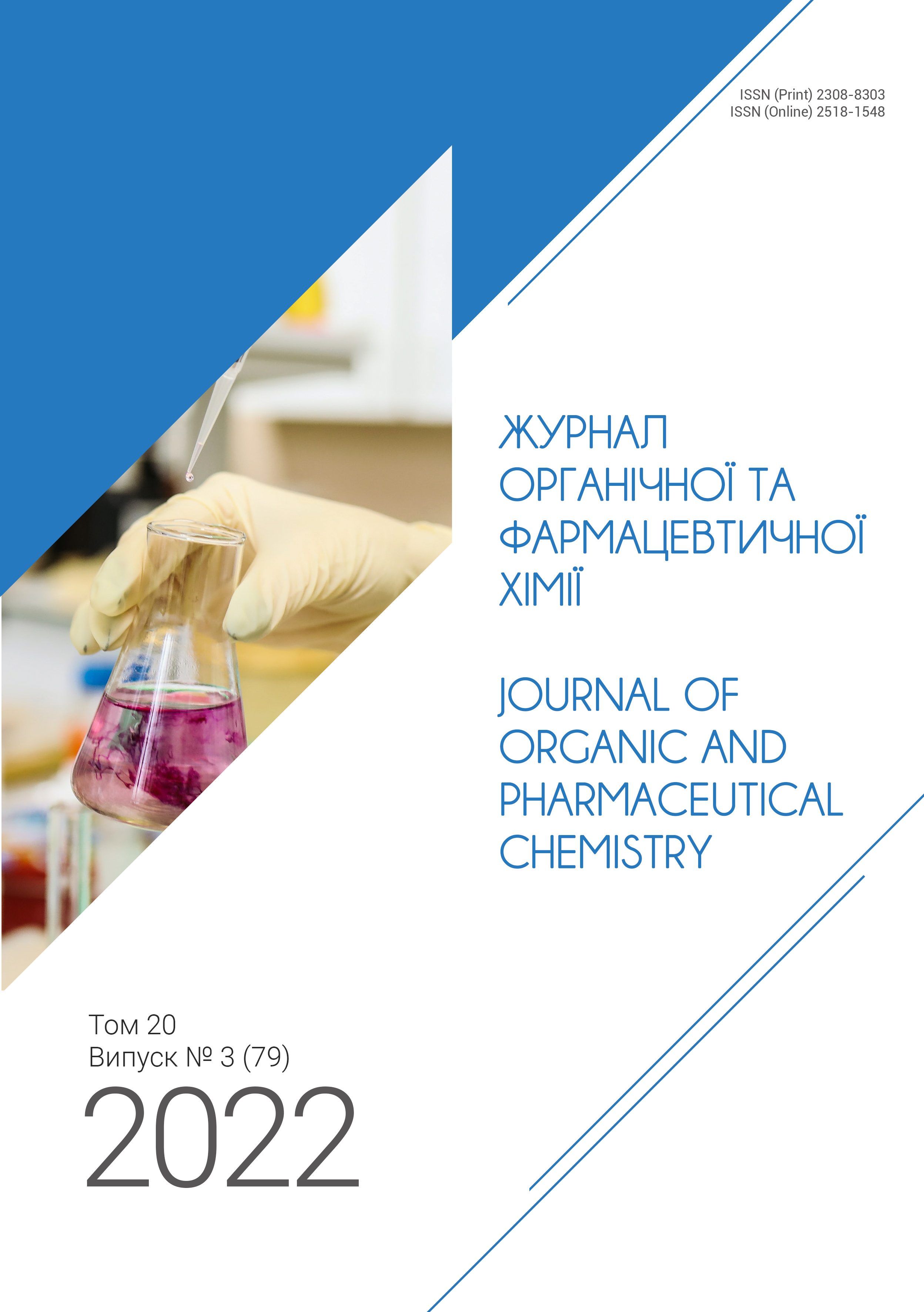N-Difluoromethylindazoles
DOI:
https://doi.org/10.24959/ophcj.22.265823Keywords:
indazoles, N-difluoromethylation, isomer separationAbstract
Aim. To study the possibility of the N-difluoromethylation and separation of 1-difluoromethyl and 2-difluoromethyl isomers of C-substituted indazoles, as well as some possibilities of functionalization of such molecules.
Results and discussion. The N-difluoromethylation of indazole derivatives containing bromine, iodine, and nitro groups in various positions of the heterocyclic ring was studied. In all cases, the conditions for the separation of isomers – N-difluoromethylation products – in positions 1 and 2 were found. The corresponding amines, esters of carboxylic and boric acids were obtained as a result of further functionalization of 1- and 2-difluoromethylindazole derivatives.
Experimental part. The structure of the compounds synthesized was proven by 1H and 19F NMR spectroscopy methods, as well as by the elemental analysis. The structure of isomeric difluoromethylindazoles was finally confirmed by the SELNOESY and 1H-13C HMBC experiments.
Conclusions. A convenient method for the difluoromethylation of substituted indazoles has been found; difluoromethyl derivatives in positions 1 and 2 of the indazole ring have been obtained in high yields. The method for the efficient separation of isomeric difluoromethylindazoles has been found; some possibilities of their further functionalization have been described.
Supporting Agency
- the authors received no specific funding for this work
Downloads
References
- Schmidt, A.; Beutler, A.; Snovydovych, B. Recent Advances in the Chemistry of Indazoles. J. Org. Chem. 2008, 2008 (24), 4073-4095. https://doi.org/10.1002/ejoc.200800227.
- Auwers, K.; Düesberg, M. Über Struktur- und Stereo-Isomerie bei Indazol-Derivaten und die Konstitution der Indazole. Berichte der deutschen chemischen Gesellschaft (A and B Series) 1920, 53 (7), 1179-1210.
- Petko, K. I.; Sokolenko, T. M.; Yagupolskii, L. M. Chemical properties of derivatives of N-difluoromethyl-and N-2-H-tetrafluoroethylpyrazoles. Heterocycl. Comp. 2006, 42 (9), 1177-1184. 10.1007/s10593-006-0222-z.
- Petko, K. I. Difluoromethylation of parent azoles. Fluorine Chem. 2018, 205, 5-7. https://doi.org/10.1016/j.jfluchem.2017.11.003.
- Petko, K. I.; Yagupolskii, L. M. Unusual difluoromethylation of 2-mercaptoazoles. Fluorine Chem. 2001, 108 (2), 211-214. https://doi.org/10.1016/S0022-1139(01)00350-5.
- Petko, K. I.; Yagupol’skii, L. M. Difluoromethylation of 5-Sulfanyltetrazoles. J. Org. Chem. 2004, 40 (4), 601-602. 10.1023/B:RUJO.0000036093.66034.cc.
- Petko, K. I.; Sokolenko, T. M.; Yagupol’skii, L. M. Difluoromethylation of Heterocyclic Compounds Containing an N=C-C Ambident Nucleophilic System. J. Org. Chem. 2005, 41 (3), 429-433. 10.1007/s11178-005-0182-2.
- Smith, N.; Kahraman, M.: Govek, S.; Nagasawa, J. Y.; Lai, A. G.; Julien, J. D.; Herbert, M. R.; Bonnefous, C.; Douglas, K. L. Estrogen receptor modulators and uses thereof. WO 2012/037411 A2, Mar 22, 2012.
- Schumacher, R.; Danca, M. D.; Ma, J.; Herbert, B.; Nguyen, T. M.; Xie, W.; Tehim, A. Indazoles, benzothiazoles, benzoisothiazoles, benzisoxazoles, pyrazolopyridines, isothiazolopyridines, and preparation and uses thereof. WO 2007/038367, Apr 5, 2007.
- Smith II, L. M.; Ladziata V.; Delucca I.; Pinto, D. J. P.; Orwat, M. J.; Dilger, A. K.; Pabbisetty K. B.; Yang, W.; Shaw, S. A.; Glunz, P. W.; Panda, M. Spiroheptane salicylamides and related compounds as inhibitors of ROCK. WO 2017/123860 A1, Jul 20, 2017.
- Hong, Z.; Hou, X.; Zhao, R.; Li, J.; Pawluczyk, J.; Wang, B.; Kempson, J.; Khandelwal, P.; Smith, L. M.; Glunz, P.; Mathur, A. A mild and readily scalable procedure for the N-1-difluoromethylation of ethyl 6-((tert-butyldiphenylsilyl)oxy)-1H-indazole-3-carboxylate and its applications to the N-difluoromethylation of indazole, benzotriazole, imidazole, indole and pyrazole derivatives. Fluorine Chem. 2020, 234, 109514. https://doi.org/10.1016/j.jfluchem.2020.109514.
- Babaoglu, K.; Brizgys, G.; Cha, J.; Chen, X.; Guo, H.; Halcomb, R. L.; Han, X.; Huang, R.; Liu, H.; Mcfadden, R.; Mitchell, M. L.; Qi, Y.; Roethle, P. A.; Xu, L.; Yang, H. Benzothiazol-6-yl acetic acid derivatives and their use for treating an HIV infection. WO 2013/159064 A1, Oct 24, 2013.
- Dominguez, C.; Juan, I. M-S.; Maillard, M.; Raphy, G.; Haughan, A. F.; Luckhurst, C. A.; Jarvis, R. E.; Burli, R. W.; Wishart, G.; Hughes, S. J.; Allen, D. R.; Penrose, S. D.; Breccia, P. Histone deacetylase inhibitors and compositions and methods of use thereof. US 2016/0039745 A1, Feb 11, 2016.
- Thomoson, C. S.; Wang, L.; Dolbier, W. R. Use of fluoroform as a source of difluorocarbene in the synthesis of N-CF2H heterocycles and difluoromethoxypyridines. Fluorine Chem. 2014, 168, 34-39. https://doi.org/10.1016/j.jfluchem.2014.08.015.
- Mao, T.; Zhao, L.; Huang, Y.; Lou, Y.-G.; Yao, Q.; Li, X.-F.; He, C.-Y. N-Difluoromethylation of imidazoles and pyrazoles using BrCF2PO(OEt)2 under mild condition. Tetrahedron Lett. 2018, 59 (28), 2752-2754. https://doi.org/10.1016/j.tetlet.2018.06.003.
Chen, X.-P.; Han, J.; Hu, Y.-J.; Li, Y.-F.; Wang, X.-C.; Ran, J.-X.; Wang, Z.-H.; Wu, F.-H. Study on the mild, rapid and selective difluorocarbene-mediated triclassification of iododifluoroacetophenone with secondary amines and tree model for product classification. Tetrahedron 2021, 78, 131762. https://doi.org/10.1016/j.tet.2020.131762.
Downloads
Published
How to Cite
Issue
Section
License
Copyright (c) 2022 National University of Pharmacy

This work is licensed under a Creative Commons Attribution 4.0 International License.
Authors publishing their works in the Journal of Organic and Pharmaceutical Chemistry agree with the following terms:
1. Authors retain copyright and grant the journal the right of the first publication of the work under Creative Commons Attribution License allowing everyone to distribute and re-use the published material if proper citation of the original publication is given.
2. Authors are able to enter into separate, additional contractual arrangements for the non-exclusive distribution of the journal’s published version of the work (e.g., post it to an institutional repository or publish it in a book) providing proper citation of the original publication.
3. Authors are permitted and encouraged to post their work online (e.g. in institutional repositories or on authors’ personal websites) prior to and during the submission process, as it can lead to productive exchanges, as well as earlier and greater citation of published work (see The Effect of Open Access).















